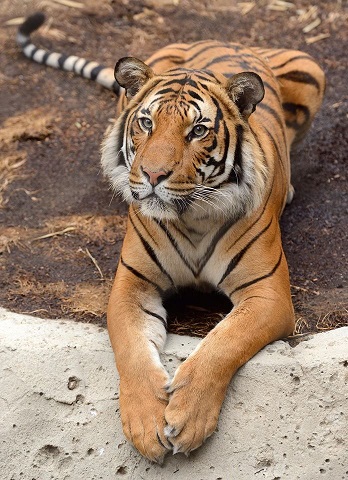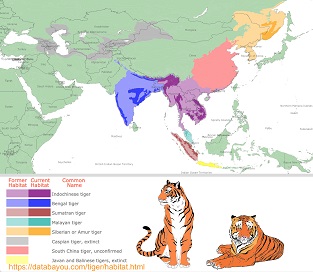

This tiger is the most recently recognized subspecies and the national animal of Malaysia. Until a few years ago it was considered the same subspecies as the Indochina tiger, but based on the genetic analysis it was discovered that they are different. Panthera tigris jacksoni emerged as a subspecies in 2004. Its scientific name comes from the tiger conservationist Peter Jackson, in honour of his years of work for tigers. but in the Malay language, it is called Harimau or just Rimau.
Malayan tiger has orange-colored body covered with black stripes. White fur can be seen around eyes, on the cheeks and belly. Black stripes are thinner compared with stripes of other tigers and they provide perfect camouflage in the jungle.
Class: Mammalia
Order: Carnivora
Family: Felidae
Genus: Panthera
So what has caused this massive decline in Malayan Tigers in Malaysian rain forest? The prime reason is hunting of tigers. Hunting is the biggest cause of the decline of not just the Malayan tigers but tigers worldwide. In Malaysia, tigers are hunted for the use of medication. This maybe surprising, but now there are probably more tigers on the shelves of pharmacies and medicine stores in Malaysia than in forests, as tigers are widely hunted for us in traditional Chinese medicine. For more than 1,000 years the use of tiger parts has been included in the traditional Chinese medicine regimens. This is because ancient Chinese culture believes that tigers have medicinal qualities because of the tiger’s strength and mythical power hence every part of the tiger is used to cure diseases. For example, their teeth are believed to be bits of help to treat chronic ailments and cure high fever. Even their whiskers are used to cure toothaches. Tiger bones are believed to contain high medicinal properties and are popular on the black market. Some even consume tiger meat as they think it would cure disease and replenish the body’s essential energy. However, there is no scientific evidence to prove this claim.
Animal poaching and illegal tradings are the other two reasons why tigers are endangered in Malaysia and across the globe. This happens simply because of the greediness of some and the ignorance of others. Malayan tigers are poached due to the high demand for products made from tiger parts. A key aspect of tiger product demand is that the wealth of the buyer which tends to drive the demand, rather than the poverty of the sellers and traders. According to Walker’s World of the Mammals, tiger skin could sell for about $16,880. According to the Wildlife Trade Monitoring Networks (TRAFFIC) , Malayan Tigers products are used for a wide variety of purposes and it is also seen as a status symbol across many parts of Asia. Another key factor, to decline in Malayan Tiger population is deforestation. Malaysia is the home to one of biggest and richest rain forest in the world which is the Borneo forest. However, which the heights of globalization and industrialization most of the precious forests in Malaysia are chopped down to build houses, malls and so on. According to Global Forest Map, Malaysia has the world’s largest deforestation rate . Last year alone, 47,278 square kilometers which are equivalent to 18,244 square miles an area larger than Denmark was chopped down. This directly affects wildlife as the forest is the home. So, loss of habitat and lack of food contributes to the lack of tigers in Malaysian rain forest.
Fines for wildlife crime were increased under the previous government - to a maximum 100,000 Malaysian ringgits ($23,884) and/or a three-year prison term.more stringent laws in relation to the illegal wildlife trade are currently with the attorney general's chambers and should be introduced to Parliament.Penalties will be designed to ensure a deterrent effect and put those in the illegal wildlife trade on notice that Malaysia is taking the crime seriously.
Between 1991 and 2003, tiger signs were reported from early-succession vegetation fields, agricultural areas outside forests in Kelantan, Terengganu, Pahang, and Johor, and many riparian habitats outside forests in Pahang, Perak, Kelantan, Terengganu, and Johor. Most of the major rivers that drain into the South China Sea had some evidence of tigers, those draining into the Straits of Malacca in the west did not.
In September 2014 two conservation organisations announced that a camera trap survey of seven sites in the three separate habitats from 2010 to 2013 had produced an estimate of the surviving population from 250 to 340 healthy individuals, with a few additional isolated small pockets probable. According to the report, the decline meant that the species might have to be moved to the "Critically Endangered" category in the IUCN list. As of 2019, due to poaching and the depletion of prey, the number of tigers in Belum-Temengor Forest Reserve has declined about 60% over a period of 7–8 years, from approximately 60 to 23.
The Malaysian Conservation Alliance for Tigers (MYCAT) is "an alliance of non-governmental organisations comprising the Malaysian Nature Society (MNS), Traffic Southeast Asia, Wildlife Conservation Society-Malaysia Programme and WWF-Malaysia.It also includes the Department of Wildlife and National Parks.
Note: International Tiger Day July 29th has been held every year since 2010 when it was first created at the Saint Petersburg Tiger Summit. This was done to raise awareness of the decline of wild tiger numbers, leaving them on the brink of extinction and to encourage the celebration around the important work of Tiger conservation.
In 2007, they implemented a hotline to report tiger-related crimes, such as poaching.In order to deter poaching, they organize "Cat Walks", a citizen patrol in danger zones.MYCAT has a goal of increasing the tiger population. Throughout 2008, Perhilitan’s game rangers carried out 174 operations and destroyed some 1,000 tiger traps and snares. “Most of the snares set up by poachers are of the wire type where it can endanger not only the big cats but other animals that pass through the spot,” “From early January 2009 until today, Team Ronda and Perhilitan have destroyed 114 tiger traps installed by poachers at the areas fringing Tasik Temenggor and Belum Forest Reserve
The Malayan Tiger is a carnivore and an accomplished hunter.
They generally feast on wild boar, deer, and the sun bear. If there are baby elephants that are weak, sick
or otherwise vulnerable, they will also seize the opportunity to capture one of these.The tiger may only make
a kill once every three or four days so, when it has killed its prey, it is likely to eat as much of it as
possible in one meal.
Due to a smaller habitat than before, and the need for food, some of these tigers
have taken to consuming livestock. This has created some ongoing issues with humans that are going to kill
the tigers in an effort to preserve their investment in ranching.
Tigers are solitary, except for mating season. Females will only be with offspring. Loose female territorial boundaries blur. Male Tigers have large, defended territories that over-lap several female territories. Gestation is about 3 ½ months and 3 or 4 altricial cubs are born, each weighing about 2 pounds. They are totally dependent on the mother for 18 months, usually staying in her range for 2 ½ years. They reach sexual maturity by 3 – 4 years of age. Longevity in the wild is to 15 years, with captive animals living to 20 years.



| Black Leopard Pics | Cub Pics | Yawning And Roaring Pics | More Big Cat Pics | Animated Gifs | Big Cat Drawings |
| More Tiger Pics |More Lion Pics | Big Cat Sounds | TLK Fan Art Sites | Postcard Sites | My Links Page | Other Lion Links | Sanctuarie Links |
| Cat Facts | Awards Won | Win My Award | List Of Cat Species | Linking Back To Here | Just 4 Kids | Big Kitty Quiz | Lake Applet Links |
| Big Cat Movies | Big Cat Cams | Big Cat Books |Search Engines | Big Cat Humor | Endangered Cats | Big Cats As Pets | Collective Nouns |
| Smaller Cat Pics | Games | Big Cat ASCII Art | Big Cat Attacks | Extinct Big Cats | Help The Big Cats | Links Page 2 | Small Cat Info | African Lion Info |
White Lion Info | White Tiger Info | Cheetah Info | Leopard Info | Black Leopard Info | Snow Leopard Info | Jaguar Info | Mountain Lion info | Siberian Tiger Info |
Bengal Tiger Info | Indo Chinese Tiger Info | South China Tiger Info | Sumatran Tiger Info | Malayan Tiger info | Golden Tabby Tiger Info | Liger & Tigon Info |
Tiger Parts N Asian Medicine Trade | Big Cat Poetry | Unlikely Animal Friends |